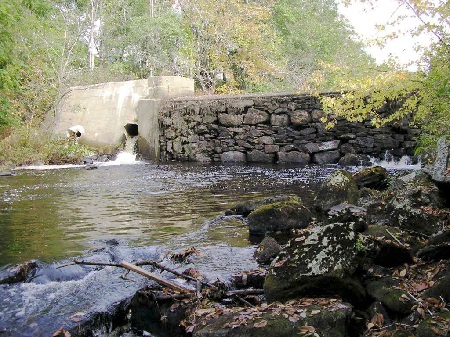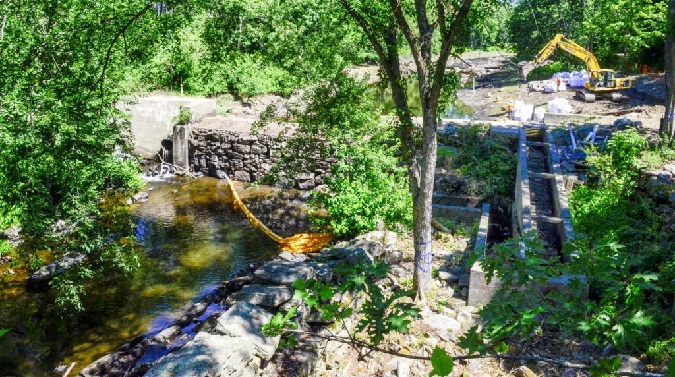 Construction efforts to remove the Coopers Mills Dam on the Sheepscot River are underway. The four-month project, which will improve public safety and fish passage, is the first phase of a multi-year effort along the 66-mile Sheepscot River to improve habitat for endangered Atlantic salmon, shad, alewives and several other migratory fish species. The broader effort includes the modification of the Head Tide Dam in Alna, new fish passage at the Branch Pond Mill Dam in China, and the upgrade of several stream crossings along the tributaries of the Sheepscot.
Construction efforts to remove the Coopers Mills Dam on the Sheepscot River are underway. The four-month project, which will improve public safety and fish passage, is the first phase of a multi-year effort along the 66-mile Sheepscot River to improve habitat for endangered Atlantic salmon, shad, alewives and several other migratory fish species. The broader effort includes the modification of the Head Tide Dam in Alna, new fish passage at the Branch Pond Mill Dam in China, and the upgrade of several stream crossings along the tributaries of the Sheepscot.
The partners in the Coopers Mills project include the town of Whitefield, the Atlantic Salmon Federation, the Midcoast Conservancy, The Nature Conservancy, the National Oceanic Atmospheric Administration (NOAA), and the US Fish and Wildlife Service (USFWS). Funding for the project was provided by many private donors as well as NOAA and USFWS.
“We are grateful for the work of a local citizen committee and the Whitefield Fire Chief to come up with a solution that will benefit the health of the river and the needs of the community,” said Andrew Goode of the Atlantic Salmon Federation.
The project includes the removal of the dam, installation of two new dry hydrants for fire protection, and enhancements to the site to improve public use and to protect the deteriorating historic mill walls on the shore.
“The structure is leaking and deteriorating pretty badly,” says Selectman Tony Marple, who chaired the citizen committee organized to review the community’s options. “After looking into the choices, it was clear that removal was the best way forward both for the fish and for the public safety provided by the Whitefield Fire Department.
“The new hydrants will provide the certainty needed of having a local water source year-round in the Coopers Mills area”, added Scott Higgins, Whitefield Fire Chief.
Town voters approved the project in 2016, after considering several options to address the deteriorating condition of the dam. The leaks in the dam had rendered the fishway and fire hydrant inoperable during the summer months.
“Today’s work is the first step to restoring critical spawning habitat for the first time in more than 200 years,” said Garrison Beck, director of water conservation for the Midcoast Conservancy. ““We look forward to working with the towns and partners to continue improving fish passage, water quality, and public enjoyment of this wonderful resource throughout the Sheepscot River.”
From the early 1800s to the 1940s, the Sheepscot River was heavily dammed to support numerous lumber, shingle, and barrel mills up and down the waterway. Today, the Coopers Mills Dam is just one of two dams that remain on the main river. Once completed, the dam site will feature informational and historical interpretive signs and areas developed for river viewing and access. The project is expected to be finished by the end of October.
“This project is important for all 12 species of sea-run fish and will strengthen the sustainability of the commercial alewife and elver Fisheries,” said Pat Keliher, Commissioner of DMR. “As fish populations rebound, the benefits will expand to all life along the river corridor and into the Gulf of Maine, where groundfish populations and coastal mammals depended on migratory fish as part of their diet”.
“The Sheepscot River is one of Maine’s most outstanding resources,” says Kate Dempsey, Maine state director for The Nature Conservancy. “Taking this first restoration step here at Coopers Mills shows that when we work together we can design projects that balance community needs with positive environmental outcomes. This is a win for nature and a win for Maine’s communities.”
“This restoration project will not only improve local community resilience, but will also restore access to valuable upstream habitats for Atlantic salmon, alewives, shad, and other sea-run fish. In addition to the direct benefits to local fisheries, alewives and shad are important prey for other popular recreational and commercial fish, such as striped bass and cod,” said Michael Pentony, regional administrator for NOAA Fisheries Greater Atlantic Region. “We have actively participated on this project for more than a decade, and are grateful to the Town of Whitefield and our other partners for reaching this critical restoration milestone.”
A brief groundbreaking event will take place at the site following the completion of the project in the fall. The public is welcome to attend.
